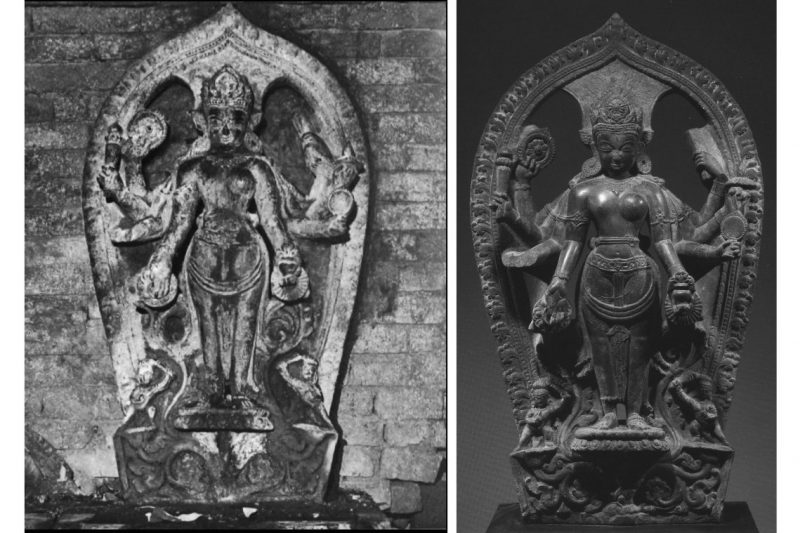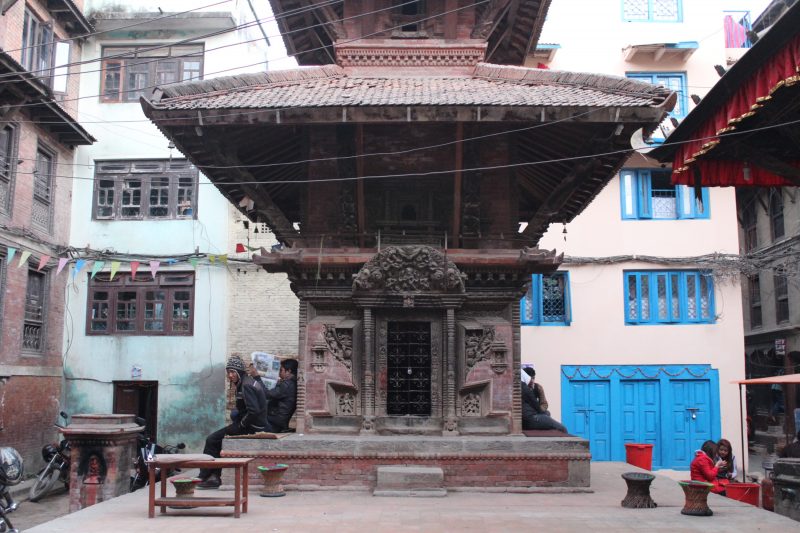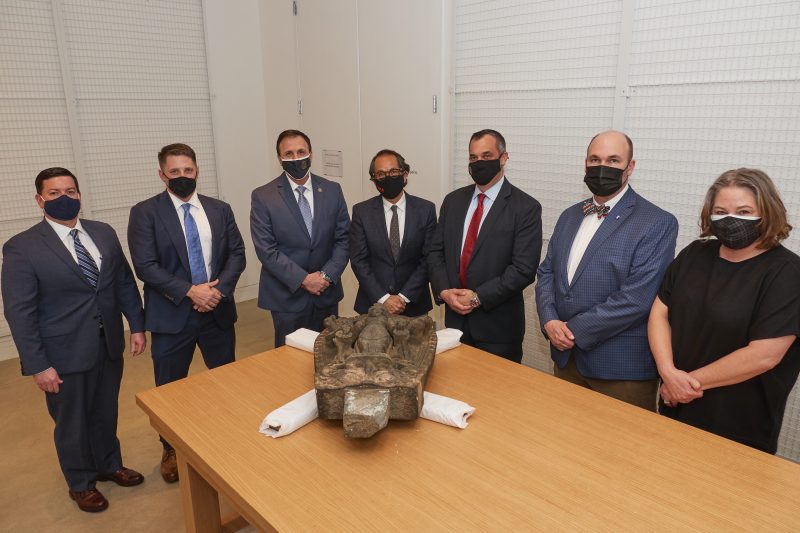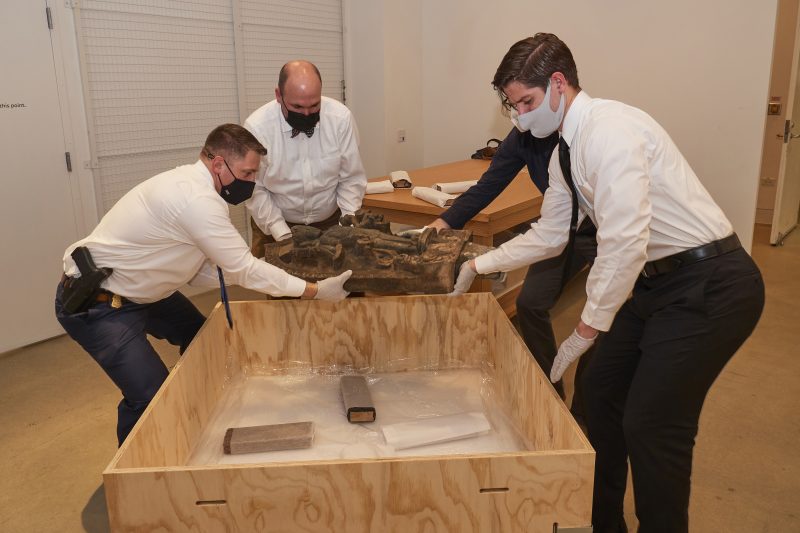Lost and Found Two presenters who met at a 2017 conference at Washington and Lee joined forces to repatriate a stolen Nepali deity.
Professional conferences usually are considered a success when attendees pick up innovative ideas, do some networking or even land a plum job. But those outcomes sound mundane compared to what happened in the aftermath of a 2017 conference at Washington and Lee University.
After meeting at a conference on the ethics of acquiring cultural heritage objects in March of that year, two presenters – artist and activist Joy Lynn Davis and Erin Thompson, an art crime professor at John Jay College of Criminal Justice – began a collaboration that would ultimately lead to an FBI investigation, a seizure from a Dallas museum, and the return of a sacred Nepali sculpture to its home almost 40 years after it was looted.
“There are so many fortuitous events that had to come about to get this sculpture home,” Thompson said, “and the conference was definitely one of the biggest.”
‘They Stole Its God’
The public temples of Nepal are filled with stone sculptures that have immense spiritual significance to locals. When Davis first visited the region in 2003, she was moved by the way its people related to the ancient objects. “Stone sculptures in particular are worshiped as living gods,” she said. “I thought that was really beautiful and interesting.”
Davis began visiting Nepal frequently, talking to its people, learning the language and photographing the sculptures that adorn hundreds of public temples and shrines throughout the country. She learned that since Nepal opened its borders to travelers in the 1950s, a staggering number of the sculptures – some estimate more than half – have been stolen. She began an art project, “Remembering the Lost Sculptures of Kathmandu,” in which she painted rich depictions of stolen sculptures in their original locations, often illuminated in gold leaf. Proceeds from sales of the paintings go to the Himalayan Art and Cultural Heritage Project, a nonprofit she founded to preserve and protect the region’s cultural heritage.
Melissa Kerin, an associate professor of art history at W&L, met Davis in Tibet in 2006. Ten years later, they reconnected when Kerin was helping to develop and organize the conference with Angie Smith, then-director of the Roger Mudd Center for Ethics. “The Ethics of Acquiring Cultural Heritage Objects” brought together disciplines of archaeology, art, art history, economics, ethics, law, and museum studies to investigate complex ethical concerns embedded within practices of acquiring these objects.
Participants included some of the most celebrated scholars in their fields, including Thompson, the only full-time art crime professor in the country. Kerin and Smith worked with Clover Archer, director of Staniar Gallery, to invite Davis to exhibit her paintings. That exhibition and Joy’s talk were central components of the conference.
One of the case studies in Davis’s talk was the Lakshmi-Narayana statue, a 10th– or 11th– century sculpture that was stolen from the Narayan Temple in Patko Tol, near Durbar Square, Kathmandu, in 1984. The statue is of two conjoined deities, Narayana (an avatar of Vishnu) and his consort Lakshmi. After the theft, the community created a replica that they continued to worship.
These sculptures “must be fed, anointed, cared for, and worshipped,” Thompson wrote in an article about the piece in the online art magazine Hyperallergic. “In turn, they care for their worshippers, protecting them and granting their prayers. The thieves didn’t just steal the community’s artwork. They stole its god.”
The theft was documented in a 1989 book, “Stolen Images of Nepal” by Lain Singh Bangdel. Six years after it disappeared, the sculpture turned up in an auction at Sotheby’s New York, but the buyer’s identity was private. Davis made a painting of the piece in its original location to include in her series.
Then, in 2015, Davis was searching images online when she stumbled across a blurry photo posted to a blog by a Nepali student living in Dallas. The image, of a sculpture the student had seen at the Dallas Museum of Art, looked awfully familiar. Davis knew immediately that she was looking at a picture of the Lakshmi-Narayana statue.
Unfortunately, the 2015 Gorkha earthquake distracted everyone from the problem of stolen sculptures. The natural disaster killed nearly 9,000 people, injured more than 20,000 and wreaked devastation across the country. “It seemed like it wasn’t a time in Nepal to talk about these individual sculptures when there had been so much damage to cultural heritage,” Davis said.
The 2017 conference at W&L brought those efforts back into focus.
Building a Case
Thompson was captivated by the paintings in Davis’s exhibit and by her talk, during which she mentioned the blurry image. “Joy gave this absolutely stunning presentation describing the results of her research and making it clear what the impact of having these sculptures stolen was to the Nepali people,” Thompson said.
Thompson bought a Davis print of the Lakshmi-Narayana sculpture, took it home after the event and hung it on her office wall. Every time she gazed at the painting, she was troubled by thoughts of the theft. She eventually reached out to Davis and proposed that they collaborate to get the deities home.
Building on Davis’s work, Thompson dove into researching the piece, soon learning that it had been purchased from Sotheby’s by a prominent antiquities collector who was a longtime patron of the Dallas Museum of Art. The piece had been on display there since 1993, when the museum opened a special exhibition of the patron’s collections called “East Meets West: Sculpture from the David T. Owsley Collection.” In 2003, according to Thompson’s findings, the patron had pledged to leave his collection of South Asian art to the museum, which opened new galleries to house his collection.
“The context is so different,” Davis said of seeing Nepali deities in American museums. “To see them gleaming on pedestals against white walls, most visitors would guess these were dug up out of the ground and part of an ancient civilization, not part of a living community.”
In November 2019, having gathered significant evidence, Thompson posted a Twitter thread about the sculpture that featured side-by-side photos of the piece in place in Nepal, at the auction house and in the museum exhibit. The tweet caught fire, and the next day, the museum replied: “The Dallas Museum of Art takes these matters very seriously, and we are currently looking into this.”
The Twitter thread and the Hyperallergic article that followed caught the eye of the Federal Bureau of Investigation, which opened a case. Davis was asked to help, so she put together an 11-page report for the bureau and Nepali authorities that included photos, GPS data and other information about the theft and the community’s response.
“We did what we could to build the strongest case, and it was overwhelmingly clear,” she said.
Homeward Bound
More than a year after the explosive tweet, in early March 2021, the FBI announced that with the cooperation of the Dallas museum and the lender, they were seizing the statue and beginning the process of transporting it back to Nepal. Agents collected the deities from the museum and transported them by car to Washington, D.C., before arranging transport back to Nepal, where the sculpture was placed in a national museum in Kathmandu.
Davis said the sculpture will ultimately be returned to the temple from which it was stolen, and the community plans to hold a forgiveness ceremony and reconsecrate the object so it can be worshiped again after its long absence. Both she and Thompson hope to attend.
“I am thrilled,” Davis said. “So much has been stolen from the Kathmandu valley of Nepal – I estimate more than 1,000 sculptures since Nepal opened their borders to foreigners. It’s really wonderful to see it go back. I hope to see more of these sculptures go back in my lifetime.”
Thompson said there is a mountain of work yet to do to return more stolen cultural heritage objects to their rightful homes around the world, not just in Nepal. Using the media megaphone to attract attention to these cases is one of the most effective ways to go about it, she said.
“So many people became aware of the issue of stolen and looted art from Nepal because of this sequence of events,” she said. “The primary goal was to get this back; the twin goal is to say that no sacred art has left Nepal legally, so any sacred art you see in the U.S. is probably stolen, even if there is not direct proof that it was stolen – that’s my opinion.”
Kerin is pleased that the conference, which also inspired research and collaboration among other attendees, played a role in connecting two people with the knowledge and passion to right a wrong that happened so many years ago. She has used this case study and the stories of other looted cultural heritage objects in many of her courses at W&L, especially Introduction to Cultural Heritage and Museum Studies, a class that examines concepts of ownership and acquisition practices. Davis is often a guest in this course, as are others from the conference.
“Every art historian is involved with the cloudy world of art acquisition, and whether we work on the academic side or the museum side, we’re all working with objects that are in collections,” she said. “You always have to ask: ‘How did they get into these Western collections?’ I think it is a question that is becoming more prevalent, it’s something we are asking more and it’s a question we’re asking students to think about more.”
 The Lakshmi-Narayana sculpture, stolen from Nepal in 1984 and pictured here in a book about Nepali art theft (left) and in a catalog from a Sotheby’s auction (right). Photos courtesy Joy Lynn Davis.
The Lakshmi-Narayana sculpture, stolen from Nepal in 1984 and pictured here in a book about Nepali art theft (left) and in a catalog from a Sotheby’s auction (right). Photos courtesy Joy Lynn Davis. The original home of the artifact was this temple in Nepal. Photo courtesy Joy Lynn Davis.
The original home of the artifact was this temple in Nepal. Photo courtesy Joy Lynn Davis. FBI agents and representatives of the Dallas Museum of Art pose with the Lakshmi-Narayana deities before packing them up for the return to Nepal, by way of Washington, D.C. Photo courtesy Dallas Museum of Art.
FBI agents and representatives of the Dallas Museum of Art pose with the Lakshmi-Narayana deities before packing them up for the return to Nepal, by way of Washington, D.C. Photo courtesy Dallas Museum of Art. FBI agents pack the Lakshmi-Narayana statue for transport from the Dallas Museum of Art to Washington, D.C., where they arranged its return to Nepal. Photo courtesy Dallas Museum of Art.
FBI agents pack the Lakshmi-Narayana statue for transport from the Dallas Museum of Art to Washington, D.C., where they arranged its return to Nepal. Photo courtesy Dallas Museum of Art.
You must be logged in to post a comment.